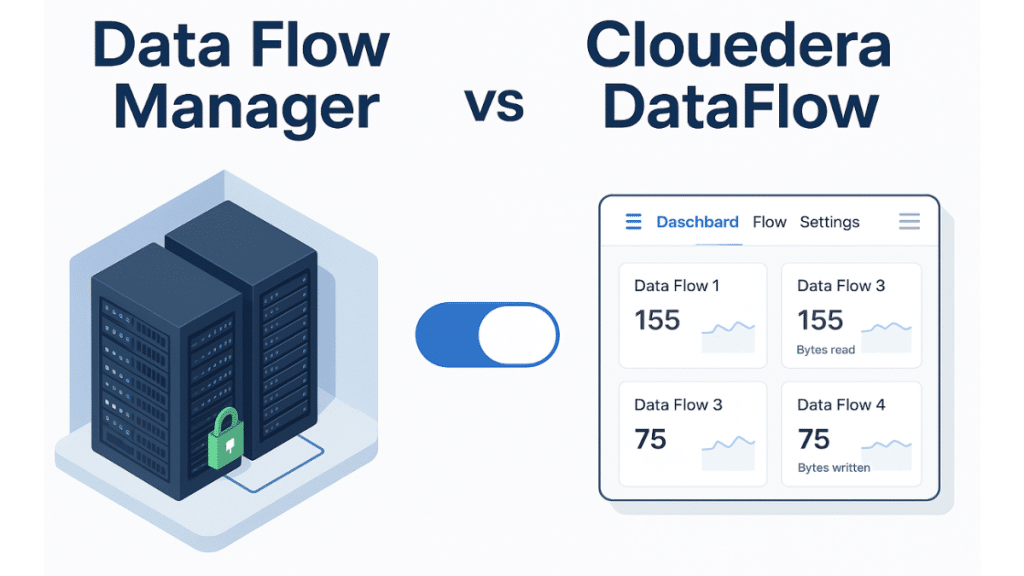As enterprises become increasingly data-driven, the need for effective, scaFlable, and cost-efficient data flow management platforms has never been greater. Apache NiFi has emerged as a popular choice for building robust data pipelines, but managing those pipelines at scale requires the right orchestration platform.
For many, Cloudera DataFlow (CDF) has served this role. But as data ecosystems evolve and priorities shift toward agility, transparency, and cost control, organizations are exploring alternatives.
This is where Data Flow Manager (DFM) enters the conversation. It is a modern, open-source, and purpose-built NiFi flow management platform designed to meet the needs of today’s enterprise.
Why Reevaluate Your NiFi Flow Management Platform?
Organizations that rely on Apache NiFi often face challenges not with the technology itself, but with how it’s managed:
- Rising licensing and infrastructure costs
- Difficulties in scaling operations
- Manual overhead in deploying and promoting flows
- Lack of visibility and version control
- Vendor lock-in that limits long-term flexibility
CDF, while offering enterprise-grade capabilities, is often accompanied by complex pricing, tight integration within Cloudera’s stack, and limited extensibility outside that ecosystem. As organizations seek more autonomy and cost transparency, a shift toward leaner, open alternatives becomes logical.
Cloudera DataFlow: Enterprise-Ready, But Heavily Coupled
Cloudera DataFlow offers a comprehensive suite for flow management across NiFi, Kafka, and Flink, especially when used within the Cloudera Data Platform (CDP). However, it comes with considerations:
- Consumption-Based Pricing: CDF pricing is typically based on compute cores or data throughput, which can be difficult to predict and manage as usage scales.
- Tied to CDP: While powerful, CDF is most effective when integrated into the broader Cloudera ecosystem, which can limit flexibility and increase migration costs.
- Operational Complexity: Flow deployments, version control, and access management often require additional Cloudera tooling and manual setup.
- Black-Box Deployments: Proprietary components can make it challenging to understand what’s running and customize behaviors.
In regulated industries or teams with mature CI/CD practices, this level of coupling and overhead can become a liability.
Data Flow Manager: Built for Open, Scalable, and Transparent NiFi Orchestration
Data Flow Manager (DFM) takes a different approach. It focuses exclusively on simplifying, securing, and scaling Apache NiFi-based data flows with a clean, open-source foundation and enterprise features layered on top.
Here’s what sets Data Flow Manager apart:
1. Predictable Pricing, Built to Scale
Data Flow Manager uses a flat-rate pricing model – $500 per node – regardless of the number of flows, data volume, or users.
- No per-core or per-GB pricing
- Budgeting is simple and transparent
- Ideal for teams operating at scale or on tight cost controls
This model gives you the confidence to scale your NiFi environments without fearing unpredictable bills.
2. Open-Source by Design, No Vendor Lock-In
Data Flow Manager is built entirely on open-source Apache NiFi, without proprietary add-ons or closed architectures.
- Security: Deploy on-premises and enjoy complete privacy.
- Transparency: Full visibility into how your flows operate.
- Extensibility: Easily customize and integrate into your toolchain.
This makes Data Flow Manager especially attractive to teams looking for long-term flexibility and independence.
3. Enterprise Features Without the Complexity
While CDF provides enterprise controls, they often come with a learning curve. Data Flow Manager simplifies operations with built-in capabilities:
- No Need to Access NiFi UI: Secure flow deployments without logging into the NiFi UI.
- AI-Powered Flow Creation: Automate initial pipeline designs using metadata and patterns.
- Visual Flow Deployment & Rollback: Promote flows across Dev, Staging, and Prod with click-based controls.
- Scheduled Flow Deployment: Automate flow deployments at a pre-defined time, be it post-business hours or on weekends, with approval workflow.
- Version Control & Rollback: Version control your flows and instantly roll back to the previous stable versions – all from a single interface.
- Role-Based Access Control (RBAC): Manage cluster-level as well as flow-level permissions across teams securely.
- Audit Logs & Provenance: Get comprehensive details of flow deployments – who deployed the flow, when, and across which cluster.
- Proactive NiFi-Specific Monitoring: Gain in-depth visibility into flow health and get alerts.
4. Native Integration with CI/CD Pipelines
Data Flow Manager fits right into your existing CI/CD ecosystem – no need for additional tools or workflow changes. With RESTful APIs, teams can deploy, validate, and manage NiFi flows directly from their CI/CD pipeline, eliminating the need to access the NiFi UI. This streamlines automation, enforces consistency, and brings flow management in line with modern DevOps practices.
Conclusion: Making the Right Strategic Choice
If managing your NiFi flows feels more complex and costly than it should be, you’re not alone. Legacy tools like Cloudera DataFlow might have gotten you started, but they often come with hidden costs, rigid architectures, and growing operational overhead.
Data Flow Manager is built for how teams want to work today – open, flexible, and automation-ready. With flat-rate pricing, seamless CI/CD integration, real-time monitoring, and no vendor lock-in, it gives you the control and clarity you’ve been missing.
